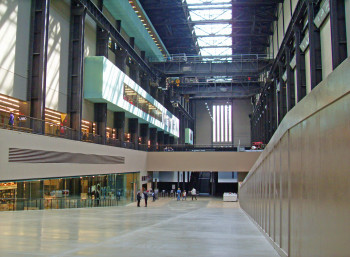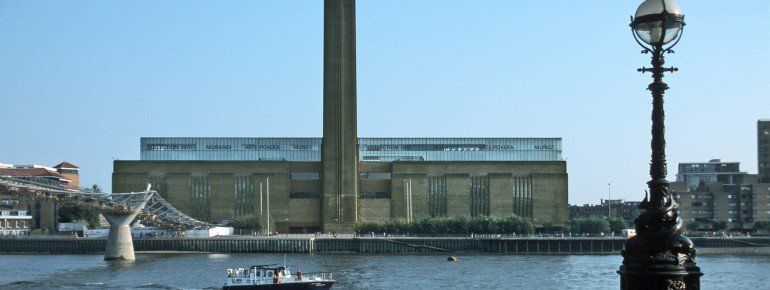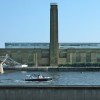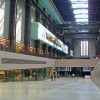Contents
Description

In addition to crown jewels and a historic old town, London has much more to offer, such as the world's largest museum for modern art, the Tate Gallery of Modern Art. The Tate Modern is located in a converted power plant, the former Bankside Power Station, on the south bank of the Thames.
The Tate Modern opened in May 2000 and has since shown a wide spectrum of modern art, from 19th-century Impressionism to works by young British artists.
The Architecture of the Tate Modern
Many who enter the Tate Gallery of Modern Art for the first time are literally overwhelmed by the size of the former turbine hall of the former power plant. Similar to a large, empty cathedral, this space, with a length of about 160 meters and a height of up to 35 meters, takes up a large part of the gallery. It even houses artworks created specifically for the space. The entire architecture of the Tate Modern, with its generously wide spaces, is characterized by the character of the power plant.
The Permanent Exhibitions
The permanent exhibitions in the Tate Modern are located on levels 3 and 5, which are each divided into two parts. The tour begins in the east of level 3 with the exhibition "Still Life / Object / Real Life". The conventional introduction with Cézanne's Still Life with Water Jug is followed by increasingly provocative artworks. In the room of subversive objects are masterpieces such as Salvador Dalí's Lobster Telephone and garbage collections by Peter Fischli and David Weiss. The west side of the 3rd level is determined by the themes "Landscape/ Matter/ Environment". In this room, artist Mark Rothko presents his works called Seagram Murals.
On the east side of level 5 are, among others, Rodin's sculpture The Kiss as well as works by renowned artists such as Stanley Spencer, Henri Matisse and Francis Bacon, which together shape the style for the eastern room "Nude / Action / Body". The west side of level 5 offers visitors works by Pablo Picasso (Weeping Woman) and Andy Warhol (Marilyn Monroe Diptych) among others, under the title "History / Memory / Society".
Those who visit the exhibition at the Tate Gallery of Modern Art should enjoy the fascinating view of London city from level 7. The east side offers a magnificent view north towards the Millennium Bridge and St. Paul's Cathedral. If you direct your gaze directly east, Shakespeare's Globe Theatre seems within reach. In the south window stands the British Airways London Eye, London's giant wheel.
Historical Information
The history of the Tate Gallery of Modern Art begins in 1916, when the Tate Gallery was commissioned to create a collection of international artworks from painting and sculpture from 1900 onwards. The collection enjoyed great popularity and was therefore enlarged enormously very quickly, making the original location in Millbank finally too small.
In order to present all exhibition pieces to the public, branches of the Tate Gallery were opened in Liverpool in 1987 and in St. Ives in Cornwall in 1993. Since May 11, 2000, the collection has been housed in the former Bankside Power Station, a closed power plant. The design for the conversion comes from the Swiss architectural firm Herzog & de Meuron. With the bridge built in the same year, the Millennium Bridge, visitors reach the center of the gallery directly across the Thames. It is thus a direct connection between St Paul's Cathedral and the Tate Modern.
In May 2003, a boat service was installed that shuttles between the London Eye and the Tate Gallery of Modern Art and bears the name "tate-to-tate".
How to get there
On foot
You can walk to Tate Modern over Millenium Bridge, which is a sight in itself. It leads straight from St Paul's Cathedral over river Thames and right to the gallery.
By tube
London Bridge and Southwark are the closest tube stations, both only a few steps away from the museum. They are connected to Northern Line. If you are travelling on Circle Line or district Line, you can get off at Cannon Street, cross Millenium Bridge, and get to the gallery that way.
By Car
It is generally not recommended to drive into central London by car. Lack of parking spaces and left-hand traffic can make some mainland Europeans waver. It's best to park the car outside and zip into the city center by Tube.







